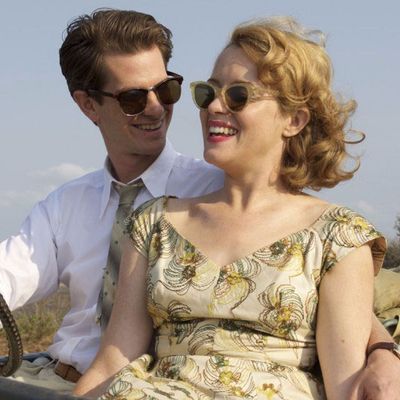
The sound of a respirator is nearly inescapable throughout Andy SerkisÔÇÖs directorial debut, and for good reason: It represents the yoke attached to Robin CavendishÔÇÖs neck, the delicate bit of machinery between him and asphyxiation. Cavendish, played by Andrew Garfield, is an adventurous newlywed working in Kenya in the late ÔÇÖ50s when one night he collapses, due to paralysis from contracting the polio virus. HeÔÇÖs left paralyzed from the neck down, barely able to speak, and dependent on the wheezing chug of a machine to keep him alive. The film is called Breathe, which is a terrible title even with this information.
Breathe, which is based on a true story and produced by CavendishÔÇÖs son Jonathan, is almost disarmingly traditional awards-season fare, and its rapid-fire opening minutes seem to shuffle through every ÔÇ£fancy movieÔÇØ clich├® in the book. ThereÔÇÖs an English manor house and a cricket game, alluring society lady Diana (Claire Foy) sipping tea, and RobinÔÇÖs friends telling him heÔÇÖd just as soon have angels fly out of his arse than get close to the likes of her. A few minutes later, theyÔÇÖre dancing at a fancy ball, engaged to be married, and shipping off to Africa where Robin is to work in the tea business. ItÔÇÖs hard to tell if the romance itself is whirlwind, or just the telling of it.
It also makes for a strange beat when trouble arrives on the doorstep in the form of RobinÔÇÖs paralysis. We barely know these people and what their relationship is based on; it feels neither inevitable nor unexpected that Diana would devote herself to RobinÔÇÖs side, which she does. After Diana has their child (future producer Jonathan) the two return to England, and Robin is presumably destined for a future in a cold, shadowy hospital ward alongside the other paraplegics. Robin quickly begins to despair, but Diana begins to take measures to make his life as worth living as possible, taking him out of the hospital against the advice of doctors so that he can live at home with his family.
This mission to maximize RobinÔÇÖs quality of life causes Diana and the coupleÔÇÖs circle of friends to accidentally stumble onto a series of breakthroughs in early disability tech. Their friend Teddy (Hugh Bonneville) is particularly ingenious, rigging up a car seat and a respirator wheelchair for Robin. The group even manage to take Robin on a Spanish vacation, which is nearly a disaster but quickly turns into the kind of serendipitous life-affirming experience that only happens in movies.
While I appreciate SerkisÔÇÖs playing against type for his directorial debut ÔÇö the movement guy, doing a polio movie! ÔÇö thereÔÇÖs something a little cloying and Harry PotterÔÇôish about his twinkling dramatic sensibility (and something very Lord of the RingsÔÇôish about his refusal to let his film end). RobinÔÇÖs climactic speech at a backward-thinking disability conference is met with a genuine slow clap, for crying out loud. He does a fine job capturing the real love and caring between the Cavendishes, but more emotionally complex questions (like, say, DianaÔÇÖs need for physical intimacy) are brought up and quickly forgotten. The film is ultimately more interested in the revolutionary nature of RobinÔÇÖs life and the innovations that would become his legacy. And itÔÇÖs a plenty good story to tell, but even by the time the respirator takes its last gasp, I was ultimately unmoved.

